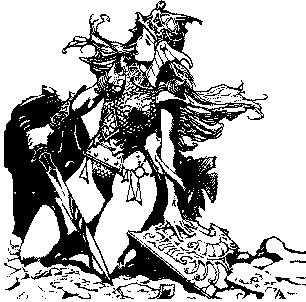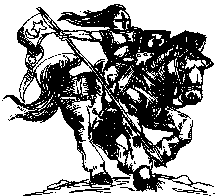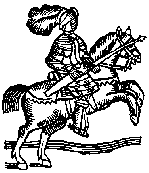

 Some rules to live by as a knight in Nannymud:
Some rules to live by as a knight in Nannymud:You should always be compassionate, willing to help people out. Helping newbies is one way to do this. This doesn't only mean giving a few coins to someone to start them out, but helping them find their way around the mud (This is actually much better as they will learn to make their own wealth.)
You should have much valour. Be brave and daring, stare death in its face. If you are partying, dont be a coward and be in the middle, be the leader and take all the hits, show everyone how strong you are!
Knights should always be honourable, respect your elders (wizzes, round table knights, etc.) they are all here to HELP you. Respect all others too, even if they are not nice to you, you should treat them the way you want to be treated, with respect and dignity.
Knights should always be honest. Keep your word, ALWAYS! The
word of a knight is as good as gold. If you are a knight
there should be no question if you are trustworthy of
anything.
Pride is good to an extent, but too much pride can be bad...
 "The word cniht was first used to describe the sons of French peasants
who arrived in England follwing the Norman Conquest in 1066. Crude in
manner and appearance, the cniht soldiers attracted attention because
of their expensive armor and horsemanship. The cnihts at this time were
still considered second-class citizens, a notch above peasants but
decidedly inferior to the aristocracy.
"The word cniht was first used to describe the sons of French peasants
who arrived in England follwing the Norman Conquest in 1066. Crude in
manner and appearance, the cniht soldiers attracted attention because
of their expensive armor and horsemanship. The cnihts at this time were
still considered second-class citizens, a notch above peasants but
decidedly inferior to the aristocracy.
With feudalisn the status of the cnight improved dramatically and eventually the term was Anglicized to Knight. The feudal era began when wealthy lords gave small pieces of land to groups of peasants in exchange for their labor, and struggling landowners signed over their property to a lord in return for protection. The relationship was secured by a bond of honor and a clear understanding of their mutual responsibilities. In time, all parties in feudal relationsips became part of the nobility, and feudal offers were extended only to those of acceptable stature.
As a lord's holdings grew, so did his need for skilled warriors to defend against foreign invaders. Knights made ideal candidates. In the feudal tradition, lords secured their services by offering them property, grand estates including much farmland, many buildings, and even the peasants who provided the labor. As the knights acquired wealth, they also gained prestige, becoming a distinct and honored social class that was usually restricted to the sons of aristocrats. opportunities to earn an honest living. The rigid chivalric code, which made abstract principles of loyalty more important than life itself, resulted in a death sentence for most knights. Few lived beyond age 30. Those who survived often spent their remaining years penniless and broken, depending on the charity of a society that had all but forgotten them."
 The 12th century was a time of key changes in the developments in Knightly
codes of behaviour. Social mores and ideals were incorporated into romances
of the day; the romances in turn became an inspiration to the Knights and
Nobles. Then, some major events took place near the end of the 12th century.
First, the Church allowed the Elevation of the Host to the congregation and
the sacred mystery was unveiled, for all could now see the Grail. Next, the
(re)discoveries in science, mathematics and philosophy, the founding of
new Military Orders, chivalry and courtly love, the building of Gothic
churches and the crusades in the Middle East. All these things when taken
as a whole provided the setting for such Orders as the Templars. The Templars,
identified as the Keepers of the Grail were seens as upholding the ideals of
Knighthood and similiar to other military orders they were half Monks and
half Warriors.
The 12th century was a time of key changes in the developments in Knightly
codes of behaviour. Social mores and ideals were incorporated into romances
of the day; the romances in turn became an inspiration to the Knights and
Nobles. Then, some major events took place near the end of the 12th century.
First, the Church allowed the Elevation of the Host to the congregation and
the sacred mystery was unveiled, for all could now see the Grail. Next, the
(re)discoveries in science, mathematics and philosophy, the founding of
new Military Orders, chivalry and courtly love, the building of Gothic
churches and the crusades in the Middle East. All these things when taken
as a whole provided the setting for such Orders as the Templars. The Templars,
identified as the Keepers of the Grail were seens as upholding the ideals of
Knighthood and similiar to other military orders they were half Monks and
half Warriors.
 The Templar's initiation rites seem to have shaped the investiture of the
Nanny knights as we known them. Templars had to obey the Master of the
Temple in all things, live without personal possessions, remain in the Order
all their lives, prevent Christians from being robbed, and protect the Holy
Land. Feudal rank was rarely taken into account in the election of the Grand
Master of the Temple and Templar society was largely a meritocracy. Guiot de
Provins (a 12th century monk who had belonged to several orders) criticized
many contemporary orders as (vile and filthy), testified to the Templars
integrity and praised them above all other religious Orders. He admitted
that he himself wasn't devout enough to enter their ranks.
The Templar's initiation rites seem to have shaped the investiture of the
Nanny knights as we known them. Templars had to obey the Master of the
Temple in all things, live without personal possessions, remain in the Order
all their lives, prevent Christians from being robbed, and protect the Holy
Land. Feudal rank was rarely taken into account in the election of the Grand
Master of the Temple and Templar society was largely a meritocracy. Guiot de
Provins (a 12th century monk who had belonged to several orders) criticized
many contemporary orders as (vile and filthy), testified to the Templars
integrity and praised them above all other religious Orders. He admitted
that he himself wasn't devout enough to enter their ranks.
Whilst the Templars (and also the Hopitallars and the Teutonic Knights) were seen as the ideal, secular Knights adapted their lifestyle to ordinary life. Servant women or peasant women did not come out of this very well. Although there were some pious Knights who did not mistreat poor women, they were few and far between. The washer women that followed the camps of crusading Knights were an exception. Although they were obviously poor women, they would not have been old women and therefore capable of drawing Knightly attention. For some reason their services were highly valued and important Knights are recorded as saying that they would rather cut down on squires and men at arms than lose their contingent of washer women when crusading in out of the way places.
 Each Knight swore to serve a Lord sometimes for a set period to undertake
a task. This was particulary in the case where the Knight was rich and
had his own funds. In return for this service he received a Knighthood
and drew a Knights' fee. Usually this meant the Knight had a small plot
of land and a yearly wage. He was required to fight for his leige Lord,
or occasionally a leige Lady, and be on duty for x many days of the year.
Usually eight of nine months during which he toured various castles and
forts and organized the men at arms, fixed defences, instructed squires
and the like. Depending on the times Knights would be allowed to joust for
themselves, or were expected to make a showing for their Lord, or Lady.
Knights reputedly had more loyalty to one another than their Lord, unless
he was also a well respected Knight. King Richard 1st (Lion Heart)
maintained a surprising degree of loyalty even though he probably couldn't
speak English, didn't spend even a year of his life in England, had an
affair with King Philip of France and leased large parts of England to
raise money for the crusades. The fact was he was outstandingly courageous,
a legendary fighter, educated and cultured and stunningly attractive and
chivalrous towards women. All and all a good knight, but a weak King.
Each Knight swore to serve a Lord sometimes for a set period to undertake
a task. This was particulary in the case where the Knight was rich and
had his own funds. In return for this service he received a Knighthood
and drew a Knights' fee. Usually this meant the Knight had a small plot
of land and a yearly wage. He was required to fight for his leige Lord,
or occasionally a leige Lady, and be on duty for x many days of the year.
Usually eight of nine months during which he toured various castles and
forts and organized the men at arms, fixed defences, instructed squires
and the like. Depending on the times Knights would be allowed to joust for
themselves, or were expected to make a showing for their Lord, or Lady.
Knights reputedly had more loyalty to one another than their Lord, unless
he was also a well respected Knight. King Richard 1st (Lion Heart)
maintained a surprising degree of loyalty even though he probably couldn't
speak English, didn't spend even a year of his life in England, had an
affair with King Philip of France and leased large parts of England to
raise money for the crusades. The fact was he was outstandingly courageous,
a legendary fighter, educated and cultured and stunningly attractive and
chivalrous towards women. All and all a good knight, but a weak King.